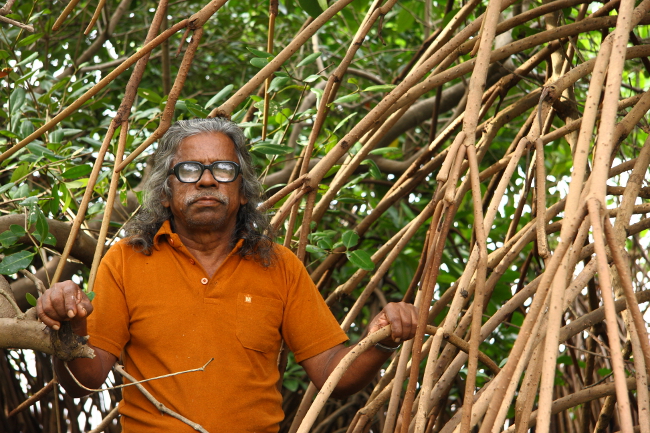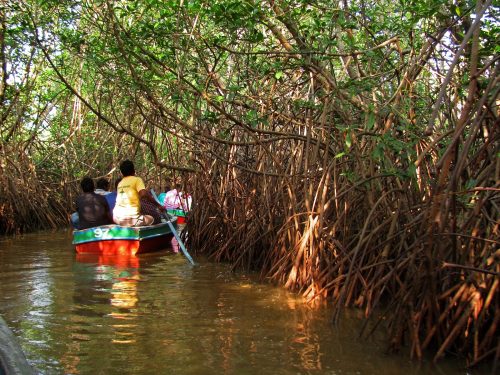Mangrove Man of India: This Farm Labourer Planted and Protected Coastal Forests for Over 25 Years!
A school dropout who grew up as a farm hand, Kallen Pokkudan's name is synonymous with mangrove conservation in India. Here's the story of his tireless campaign to protect this unique ecosystem.

The sleepy village of Ezhom, on the banks of Pazhayangadi river in Kannur district, has, at 500 acres, the longest contiguous stretch of mangroves in Kerala. A natural shield against flood, erosion, salinization and natural calamities like tsunami, this lush green coastal forest is the reason why there is always a cool breeze sweeping across the village even at the height of summer.
The man responsible for nurturing these rich wetlands was an agricultural labourer from Ezhom who dropped out of school in 2nd standard.
Kallen Pokkudan spent over two decades of his life planting, preserving and tirelessly campaigning for the protection of mangroves. In that span of time, he planted over one lakh mangrove seedlings along riverbanks and the sea shore.

Photo Source
Born into a poor Dalit household, Kallen had to drop out of school at an early age due to financial difficulties and grew up working as a farm-hand along with his parents. Made aware of the importance of environmental protection by the popular agitation against the Silent Valley hydroelectric project in the 1970-80s, he found himself wanting to do something about the wanton destruction of mangroves in his area.
In 1989, when a storm swept off children walking back from school, Kallen decided to plant mangrove saplings along the riverbank to protect both, the fast-eroding coast and the village children, from the ferocious intensity of storm winds.
Environmentalists had not begun to pay attention to the destruction of mangrove forests in the state and the Coastal Regulation Zone Act was yet to come into force. But Kallen knew that mangrove forests supported a wealth of life, from starfish to people. During the days when his family did not have a handful of rice to eat, Kallen would always find something to feed his family.
So, he started planting, nourishing and protecting tiny mangrove forests along shores and rivers. Every day he would plod through the waterlogged mud or sail along in his little canoe, planting saplings till late afternoon. In between, he would eat his packed lunch, take a small nap on the canoe and drop a line for his favourite fish.

Photo Source
Kallen used to plant a particular variety of mangrove tree that was locally known as the Praanthan Kandal (literally, the mad mangrove). In time, his fellow villagers started calling him by the moniker Praanthan Pokkudan. His work earned him enemies too, including villagers who saw greater benefits in building roads by destroying mangroves.
Often, he would wake up to find his saplings plucked and thrown into the river. Undeterred, Kallen carried on with his mission. Whenever he got the time, he would corner the village kids, spending hours telling them why it was important to protect the vanishing natural mangrove forests of the state.
Also Read: This Ecological Miracle in Kolkata Is Also the World’s Largest Organic Sewage Management System!
With one foot on land and one in the sea, mangroves live their life on the edge. Yet, they are among the most productive ecosystems on Earth. These forests of the tide provide nursery grounds for fish; a food source for monkeys, deer, tree-climbing crabs, a nectar source for bats and honeybees and a home to birds, squirrels and countless other creatures.

Photo Source
In two years, the 300 saplings Kallen had planted grew into thick green foliage spanning a kilometre. This made the state’s forest department sit up and take note of his work. They began collaborating with him by setting up a mangrove nursery and organising public awareness campaigns about mangroves.
Gradually, Kallen’s efforts started paying off. People in the region began putting up a collective resistance against the destruction of mangroves. Panchayats began booking cases for destruction of mangroves, with mangrove conservation schemes finding a place in their annual plan for the first time.
Ridicule made way for respect and recognition as environmental activists realised the immense ecological value of Kallen’s work. He was honoured with several prestigious awards including the State Forest Department’s first Vanamithra award, Harithavyakthi award, P V Thampi Environmentalist award and Bhoomi Mithra award. Kannur University also conferred the title of Acharya on him.
However, the green crusader was not ready to hang up his boots yet. He travelled across Kerala, delivering lectures about the importance of mangroves in schools and elected local bodies.

Photo Source
With the help of professional writer, he wrote three books about his life and work. A veritable one-man army, he also started a ‘mangrove school’ to train the young generation on the importance of wetland conservation.
By then, his name had become synonymous with mangrove conservation in India and he was affectionately known as Kandal Pokkudan, ‘Kandal’ being the local term for mangroves. Scientists from across the world wrote to him, seeking his advice and viewpoints.
When Attila Bankovich, director of the Hungarian Institute of Ornithology, visited the mangroves Kallen had planted in Kannur, she was astonished to see the rich diversity that thrived there. The newspaper report that quoted Bankovich as saying: “This much biodiversity you cannot see anywhere else in the world. This should never be destroyed.” was one of Kallen’s prized possessions.
When Kallen passed away in 2015, at the age of 78, India lost the man whose selfless love for mangroves had made the country sit up and take note of the importance of this unique ecosystem in environmental protection. However, his legacy is safe in the hands of youngsters like P.V. Abdulla Muhammed. A 19-year-old from Kerala, Abdulla aspires to be an environmental scientist and has set up a unique nursery that produces over 10000 mangrove saplings every month for distribution to anyone interested in mangrove cultivation.
If you would like to help in the conservation of mangroves, contact Mangrove Society of India here.
You May Like: VIDEOS: Mangroves – Protecting Coastlines, Combating Climate Change & Saving Corals
Like this story? Or have something to share? Write to us: [email protected], or connect with us on Facebook and Twitter.
NEW: Click here to get positive news on WhatsApp!
If you found our stories insightful, informative, or even just enjoyable, we invite you to consider making a voluntary payment to support the work we do at The Better India. Your contribution helps us continue producing quality content that educates, inspires, and drives positive change.
Choose one of the payment options below for your contribution-
By paying for the stories you value, you directly contribute to sustaining our efforts focused on making a difference in the world. Together, let’s ensure that impactful stories continue to be told and shared, enriching lives and communities alike.
Thank you for your support. Here are some frequently asked questions you might find helpful to know why you are contributing?


This story made me
-
97
-
121
-
89
-
167













